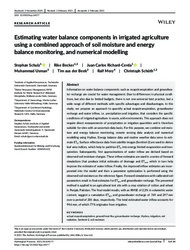Estimating water balance components in irrigated agriculture using a combined approach of soil moisture and energy balance monitoring, and numerical modelling
Becker, Rike
Richard‐Cerda, Juan Carlos
Usman, Muhammad
aus der Beek, Tim
Merz, Ralf
Schulz, Stephan; Becker, Rike; Richard‐Cerda, Juan Carlos; Usman, Muhammad; aus der Beek, Tim; Merz, Ralf; Schüth, Christoph, 2021: Estimating water balance components in irrigated agriculture using a combined approach of soil moisture and energy balance monitoring, and numerical modelling. In: Hydrological Processes, Band 35, 3, DOI: 10.23689/fidgeo-4261.
 |
Dokument öffnen: |
Information on water balance components such as evapotranspiration and groundwater recharge are crucial for water management. Due to differences in physical conditions, but also due to limited budgets, there is not one universal best practice, but a wide range of different methods with specific advantages and disadvantages. In this study, we propose an approach to quantify actual evapotranspiration, groundwater recharge and water inflow, i.e. precipitation and irrigation, that considers the specific conditions of irrigated agriculture in warm, arid environments. This approach does not require direct measurements of precipitation or irrigation quantities and is therefore suitable for sites with an uncertain data basis. For this purpose, we combine soil moisture and energy balance monitoring, remote sensing data analysis and numerical modelling using Hydrus. Energy balance data and routine weather data serve to estimate ET0. Surface reflectance data from satellite images (Sentinel‐2) are used to derive leaf area indices, which help to partition ET0 into energy limited evaporation and transpiration. Subsequently, first approximations of water inflow are derived based on observed soil moisture changes. These inflow estimates are used in a series of forward simulations that produce initial estimates of drainage and ETact, which in turn help improve the estimate of water inflow. Finally, the improved inflow estimates are incorporated into the model and then a parameter optimization is performed using the observed soil moisture as the reference figure. Forward simulations with calibrated soil parameters result in final estimates for ETact and groundwater recharge. The presented method is applied to an agricultural test site with a crop rotation of cotton and wheat in Punjab, Pakistan. The final model results, with an RMSE of 2.2% in volumetric water content, suggest a cumulative ETact and groundwater recharge of 769 and 297 mm over a period of 281 days, respectively. The total estimated water inflow accounts for 946 mm, of which 77% originates from irrigation. Approach to quantify ETact, GWR and water inflow that considers the specific conditions of irrigated agriculture in warm, acid environments. It combines soil moisture and energy balance monitoring, remote sensing data analysing data analysis and numerical modelling using Hydrus. The final model results suggest that GWR accounts for one third of the total water inflow, of which 77% originates from irrigations.
image
Statistik:
ZugriffsstatistikSammlung:
- Geologie [933]
Schlagworte:
actual evapotranspirationground heat flux
groundwater recharge
Hydrus
irrigation
net radiation
Sentinel‐2
soil moisture
This is an open access article under the terms of the Creative Commons Attribution License, which permits use, distribution and reproduction in any medium, provided the original work is properly cited.

